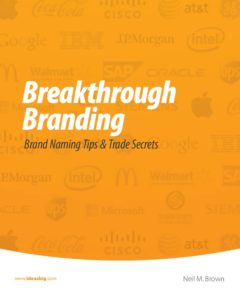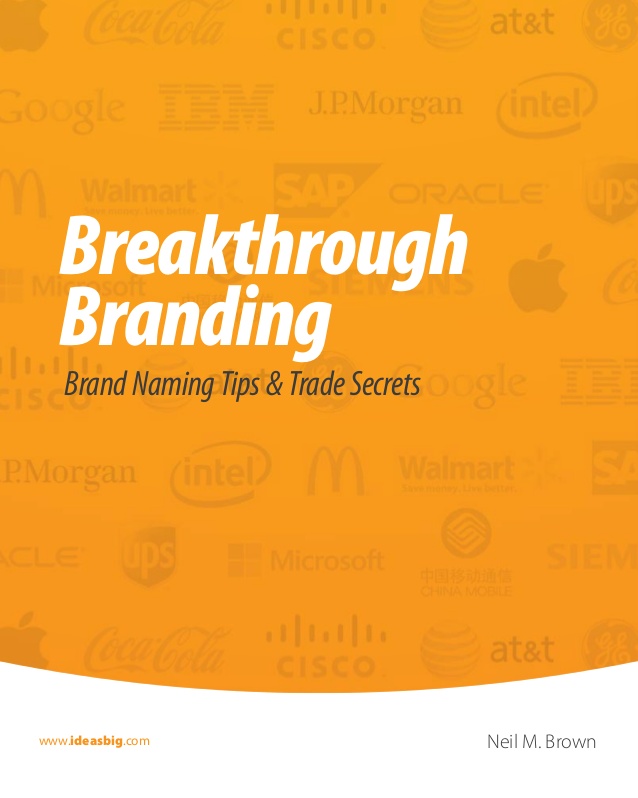
AN EXECUTIVE SUMMARY OF
Brand Naming Tips & Trade Secrets
by Neil M. Brown
Who is Neil M. Brown?
Neil M. Brown is founder and chief branding officer of Ideas BIG, a full-service branding agency.
My General Thoughts on the Book
This is a solid product naming book. It provides a lot of good realistic slap-in-the-face positions regarding the product naming process, but does little to inspire creative name generation. Like most product naming books, it contains some great nuggets of wisdom hidden within a lot of the usual discussions. The book is short and easy to read, so if you can’t afford to hire a naming expert it is definitely worth reading (just don’t expect it to be the book to get your creative juices flowing).
Preface
This book starts off strong with the preface establishing that “your brand name is the foundation of all that is marketing.” In fact, “a name can do more for achieving desired positioning than a budget the size of Australia’s GDP,” and “the best brand names tell a story, and make marketing easier.” I like that Neil leads the book with the statement “a disciplined naming process will be shared that entails category and customer insight, competitive positioning and more.” Discipline is essential to success in product naming. There are very few success stories related to product and service names build upon ad hoc and informal systems. Let’s see if this rings true.
Chapter 1: Naming: The Most Important Marketing Decision
This chapter starts off informing the reader of the power of a company or product name, but “not even the best name can save a bad product or idea.” Neil explains that “brand name development is certainly one of the first, and very likely, most important steps in marketing, and can dictate success or failure.” At first these quotes seem to contradict, but I agree that both can indeed be true.
As a seasoned trademark attorney, I appreciate the early honesty that “trademark conflicts during a name development exercise can approach 80-90%.” I have spent 16 years, and have probably performed well over a 1000 comprehensive trademark searches, yet clients still don’t want to believe this fact. I try to explain that this is part of the process, and that if you get discouraged by this success rate, rather than look at the naming process as a fun challenge, then you will settle on a convenient name rather than a great name that is protectable. If this describes you, then do yourself a favor and hire someone to develop names for your product or service, it will be worth it.
Unfortunately, naming experts often add to the frustration of the process by letting clients “in” on the process, which inevitably leads to falling in love with a name, or names, only to be later disappointed when a trademark attorney explains all the risks associated with their newfound love interest. Sure, every naming expert say they do an initial trademark “screening,” but let’s face it, this means that someone, most likely a low level person in their office, plays around on the trademark office website and does not possess the legal education to properly screen names, often excluding names that are viable options, but more often they keep names on the “list” that are not viable options. This is often only discovered at the conclusion of the naming expert’s engagement when the client then takes their beloved name to a trademark attorney for a comprehensive clearance search, which more often than not will reveal the warts associated with the name. Then the cycle starts all over again. Rinse and repeat. This is why I finally broke down and got into this industry to offer a solution to break this viscous cycle. Next time you are interviewing naming experts for a project, ask if they offer a refund, or will perform the process again at no cost, if selected name turns out to have a low likelihood that you will be able to protect it, or worse yet – if it exposes you to a risk level you are not comfortable with upon completion of a comprehensive search by a trademark lawyer. The blank looks, silence, stammering, and side-stepping will amaze you.
Enough of my rant, back to the book. Again, kudos to Neil for putting this front and center, now let’s see if the book identifies a solution. I have high hopes because he states “too often, naming is subjective or poorly executed, without disciplined processes that are used in other business areas.” For instance, “while other departments employ statistical process controls and black-belt quality initiatives, marketing may coordinate a naming contest in which the “favorite” name is voted on by employees.” I have yet to hear a true success story regarding building and protecting a brand based upon a naming contest.
Chapter 2: What’s Your Name Type?
This chapter lays out the 4 basic types of names identified by Neil’s agency, namely literal, synthesized, metaphorical, and hybrids. This significantly less than the 29 different types identified in “Don’t Call it That” by Eli Altman.
Neil states that “in any given market segment, most names fall into literal, or sometimes called descriptive name types.” He then identifies synthesized names as “made up words, most often the combination of two words or key words, sometimes called coined names.” Neil goes on to explain that metaphorical names create an association, or ideally, an emotional response that somehow relates to the company or product in an intuitive or relevant way.” Lastly, he describes the hybrid category as “a combination of name types, often literal and metaphorical.”
The chapter explains that “of the four name types, metaphorical names offer the opportunity to change whole business categories or industries, sometimes with the name itself generating publicity far greater than paid media exposure.”
I feel this is the weakest chapter of the book. The description of Neil’s proposed 4 basic types of names is unclear and confusing. I still prefer categorizing names based upon the classic “distinctiveness spectrum” known in the trademark field including the 5 categories of generic, descriptive, suggestive, arbitrary, and fanciful/coined (from least distinctive to most distinctive). Whether you like it or not, these are the categories used in the legal system when trying to protect your name and enforce your trademark rights, so it is best to embrace these legal categories and understand how they impact the strength, or weakness, of potential names.
Chapter 3: Secret Sauce: The Naming Process
In this chapter a 10-step process to optimize name development is discussed. The process includes (1) category research, (2) customer analysis, (3) competitive analysis, (4) keyword generation, (5) positioning platforms, (6) name generation, (7) name scoring and ranking, (8) trademark, domain screening & review, (9) final name evaluation and testing, and (10) name selection.
Steps 1 and 2 need no explanation. I like that Neil includes a competitive analysis as step 3 of the process because some name consultants shy away from competitive analysis under the premise of possibly negatively influencing the naming process, a legitimate concern – but I believe the positives outweigh the negatives. The explanation of the remaining steps is cursory at best, and left me looking for more meat. One sentence in particular rubs me the wrong way, namely “if any potential trademark conflicts exist, engage legal counsel to conduct a trademark legal opinion.” Again, so who is making this determination of whether a conflict exists in order to know whether to engage counsel? What experience do they have with trademark registration, enforcement, and defense? Seems like the classic issue of which came first, the chicken or the egg?
The chapter does provide a nice real world beer naming case study, but a sentence within the examples references “our proprietary Name Optimization™ process ranks name candidates on 8 criteria…” Really? “Name Optimization” is the best name that could be developed for this proprietary process. Not a good selling point for creativity or understanding of what can actually be protected. In fact, the name could be a case study of a service name that is not protectable because it is purely descriptive of the associated service. Despite their use of the common law trademark symbol, a competitor of Neil’s agency could use the term “name optimization” for their services, and after consulting trademark counsel, Neil’s agency would likely have to accept that trying to prevent such use would be futile.
Chapter 4: Do-It-Yourself Names
This chapter does a great job of identifying common problems encountered when companies develop names in-house, which I realize is self-serving but they are common problems nonetheless. I agree with Neil’s point that “without training in name development or understanding of naming best practices, there will be a tendency toward mediocre literal or synthesized names, without breakthrough potential.” Another good case study is included.
Chapter 5: Tips on Taglines
Golden! Few naming books delve much into the subject of taglines, and this chapter does a great job of illustrating the value of a tagline. It includes examples such as Taco Bell’s “Think Outside the Bun,” “Pork, The Other White Meat,” Bouty’s “the quicker picker-upper,” and “don’t get mad, get Glad.” Once again, the chapter provides another great case study.
Chapter 6: Trademark Registration
There is no doubt that every product naming book needs to cover this topic, but I cringe as I read the coverage of this critical subject. Why? Sentences like “obviously dead or non-active trademarks are not a conflict.” What! While dead trademark registrations may not be a bar to registration, a senior user of a mark can always present risks that must be considered when selecting a name.
Chapter 7: The Domain Name Game
Skip this chapter and read what Alexandra Watkins says in the book “Hello My Name is Awesome” regarding domain names.
Chapter 8: More Brand Naming Case Studies
I love case studies, so I enjoyed this chapter even if I didn’t agree with much of it.
Chapter 9: Best and Worst Brand Names
This is a very interesting chapter. I learned that Google started in 1996 as BackRub, and the current name stems from a misspelling of googol. Also, did you know that Samsung literally translates to “Three Star?” I think I would have gone for 5 stars. This chapter reminded me, and should remind you, of the power of a tag line such as “With a name like Smuckers, it has got to be good.” Neil also provides nice examples of bad brand names.
Chapter 10: Branding Beyond Naming
This chapter is a bit elementary, but nonetheless a good primer to those new to branding and product naming. It lays out the differences between brand strategy, brand identity, brand management, and brand experience, as well as how on impacts the other, and marketing in general. Good examples are included related to visual identity and sample identity guidelines.
Chapter 11: Confessions of a Namer
“One reason for ineffective naming is the all to common use of task forces and multi-functional teams that deploy in billion dollar corporations daily to address the infrequent requirement of naming or re-naming a company, new product or service.” Very true. This short chapter identifies the inherent issues with such unorganized and poorly planned naming processes. Sure, much of the chapter is promotional and self-serving, but it contains some nuggets of wisdom and includes a nice list of names and taglines that Neil created and is proud of. I have to admit, majority of them are pretty great, but I would have left the following off the list, and would have bet that they were not developed by a product name consultant: “Franchise Service” for a franchise consultant, “Extreme Practice Makeover” for a book name, “Weld Smarter” for welding equipment, and “NiteLights” for exterior lighting.
Chapter 12: Naming Resources
This chapter contains a short list of generally obvious resources, but kudos are in order for including the International Trademark Association (INTA), which has a wealth of great information. Additionally, it includes an excellent list of recommended books on naming and branding.
The Take-Away
This is a decent book that is worthy of your time and money, just read it in combination with several other product and service naming books. Will it help you create a product or service name that minimizes the wobble? Not on its own.
I hope you enjoyed this book review. Please join our email list if you would like to be notified when I post additional reviews of product naming books by brand name experts; and don’t hesitate to email me (Dave@HobbleTheWobble.com) with suggestions of additional books to review.

